In Your Eyes – Interview with Jacqui Burke – Japan 2023
30th April 2023
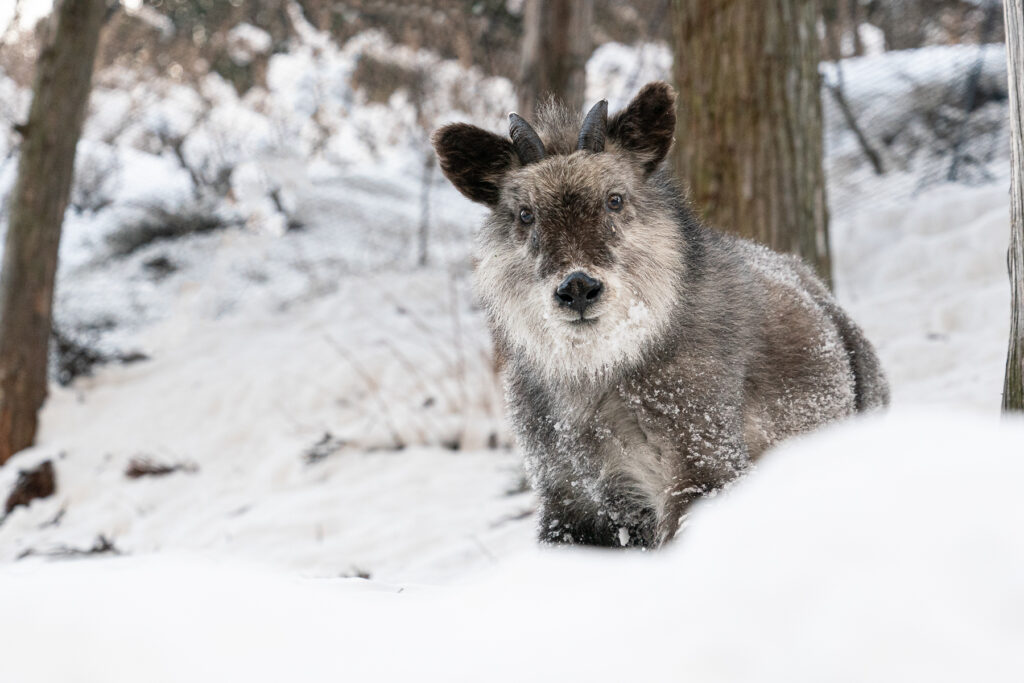
Portrait of a Japanese Serow (image by Jacqui Burke). Why Wild Images loves this – Is it a wolf? Is it a dog? Is it a goat? Is it a deer? Japanese Serows always seem to look like a mythical creature out of the book “Where The Wild Things Are”. They look like an artist has dreamed up an animal from a mix of others. We only occasionally see them so well on our tours as these shy antelope tend to stay uphill from us on the rocky slopes. Jacqui not only was lucky to see one like this, but her photo really shows how adorable these sturdy and sure-footed these antelopes are in their snowy world.
Tell us a little more about your photography journey. How long have you been taking photos?
Thank you so much for asking me to tell you more about myself and my photography as I consider it an honor, and I am pleased that my photography has progressed to the point at which I am asked to share my photos. My interest in photography grew from my interest in wild animals. From the time I was a child, I was intensely interested in wildlife. I passionately read every child’s magazine and then every adult magazine about wildlife that I could find, and watched every available documentary on television. I finally began to be able to travel to see animals in the wild about a decade ago. At first I was content to see the animals through binoculars and to revel in the moment, but then I saw other participants on the trips and the photos that they were getting, and I wanted that for myself as well. I bought my first DSLR as an end-of-the-year present to myself in 2014 and began my photographic journey in earnest. I still only photograph wildlife and other nature subjects, but as I think about my upcoming retirement I may branch out into other aspects of photography as well.
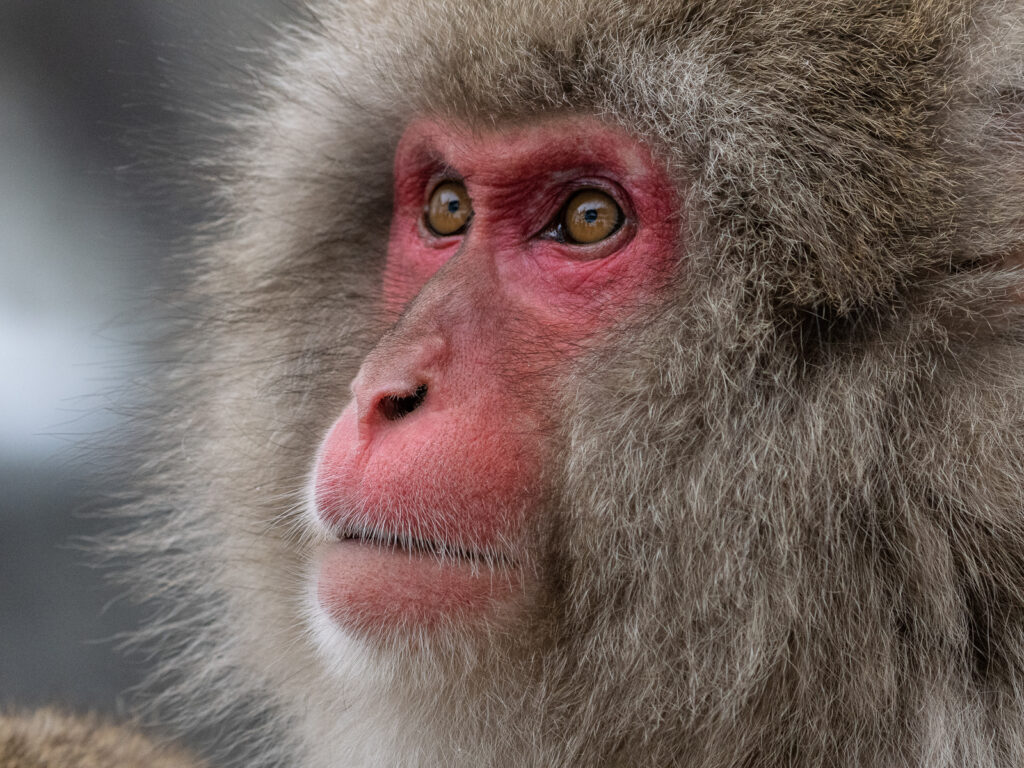
Close-up of a Japanese Macaque (image by Jacqui Burke). Why Wild Images loves this – When Japanese Macaques have their winter pelage, it is contrasted beautifully with their red faces. Here you have great detail of this animal’s fur while also being able to see the photographers reflected in its eyes.
What are you passionate about besides photography? What do you do in your free time?
My other major passion in life has been horses. I got my first horse when I was twelve years old, and except for a few years when I was in veterinary school I have owned a horse continually ever since. I have competed in horse shows, eventing, and dressage. Unfortunately, it was necessary to retire both horses last year due to infirmities of old age, but horsekeeping still takes up a lot of spare time.
I am an avid reader and have an extensive library. Most of my reading is about natural history subjects, often about the animals I hope to see on future trips. I also enjoy the card game of bridge as it is an intricate and intriguing game requiring decades to really master.
Finally, I recently became a full-on vegan due to having an elevated cholesterol level, and I have discovered a long dormant interest in cooking. I have eliminated all animal products, refined sugar and grains, and added salt from my diet. Foods have a great flavor now and I love experimenting with recipes and making my own creations.
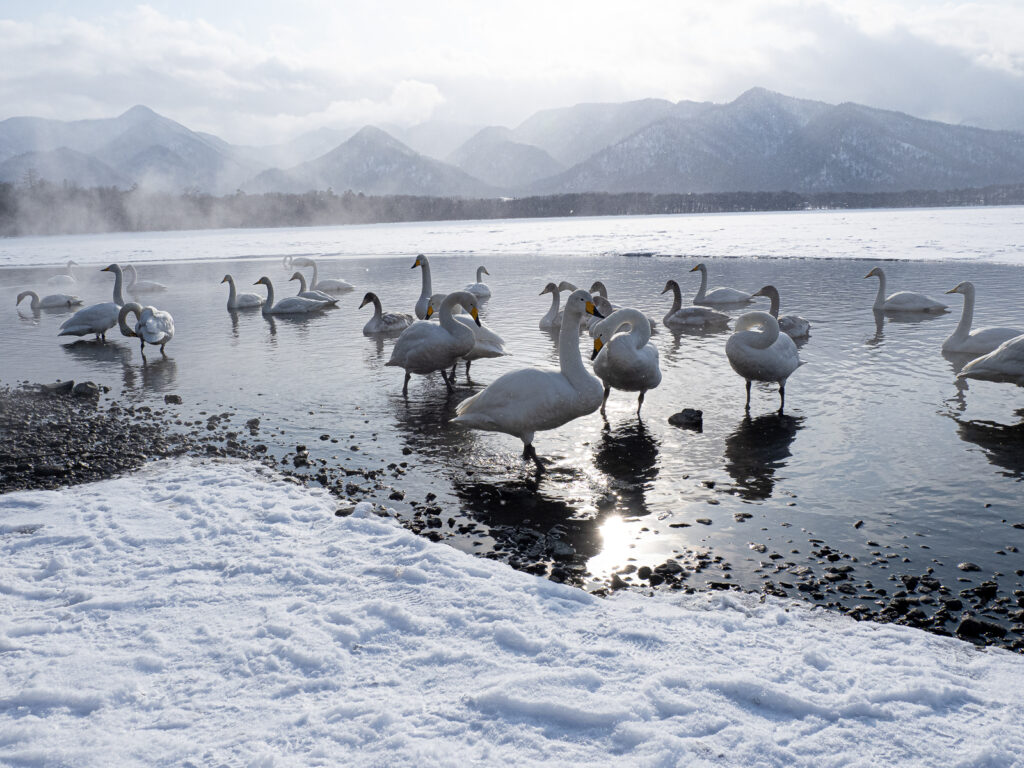
A flock of Whooper Swans in the mist of Lake Kussharo (image by Jacqui Burke). Why Wild Images loves this – Photographing the Whooper Swans at Lake Kussharo is almost like being transported to natures “Swan Lake” ballet. This image is beautiful as the swan flock is layered beautifully with the snowy shoreline in the foreground and the mist covered hills and the frozen lake in the background. These different layers really transport a viewer into the surreally beautiful winter world of these birds.
What drew you to visit Japan?
I was particularly intrigued by seeing photos and videos of the snow monkeys in the hot springs. I found it hard to fathom that monkeys would voluntarily go into a hot spring and I dearly wanted to see these monkeys of the snow and ice for myself.
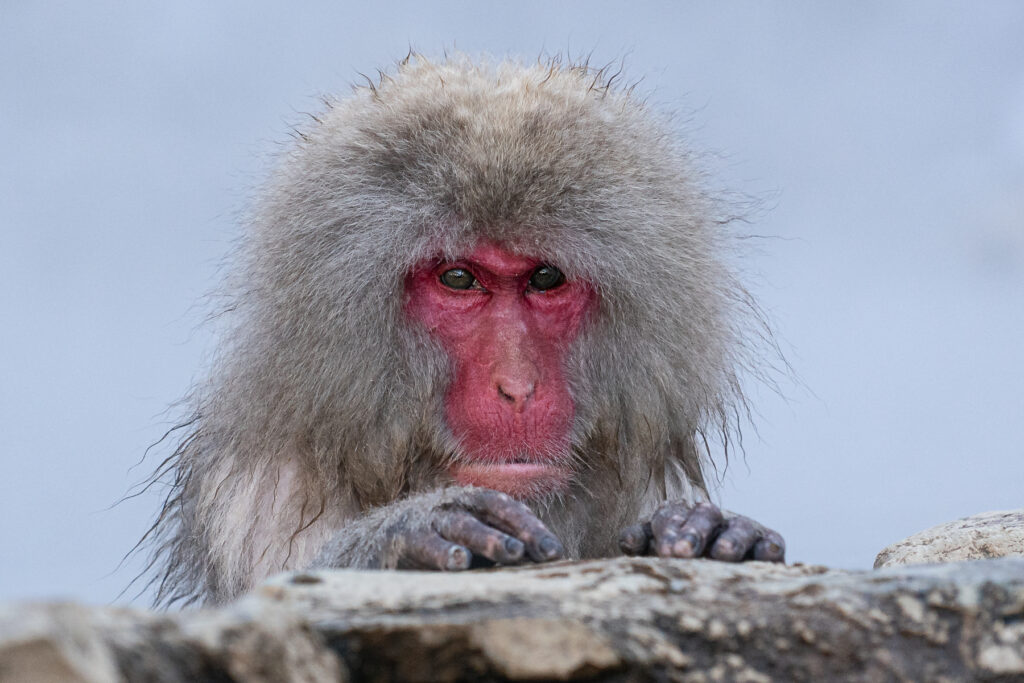
Folorn Japanese Macaque (image by Jacqui Burke). Why Wild Images loves this – even though Japanese Macaques are used to the snow, it doesn’t mean they always like it. We’ve often seen them sitting on the water pipes from a thermal spring trying to stay warm but a lot of them also like to plunge into their own thermal spring ‘bath’ and this little guy looks singularly unimpressed by the cold air outside his warm bath. The expression on his face is priceless!
What camera gear did you use on your tour?
I have recently switched to the Olympus micro 4/3rds system, and I am loving it! The micro 4/3rds cameras have a sensor that is only half the size of a full frame camera, so the entire camera and lens is much smaller and lighter than my previous full-frame Sony. My small 100-400 mm lens offers the same field-of-view as a 200-800 on a full frame body with a much smaller form factor, making transport for international trips easier, and making it easier to hike with the camera and to hold it up for extended periods. The Olympus camera also offers some advanced features not found on other brands. Perhaps my favorite of these is ProCapture. ProCapture allows photos to be saved to the buffer but not written to the card when the shutter button is half pressed. When it is fully pressed, the camera then writes those images to the card, as well as new images if the shutter is continued to be held down. I find this really useful in getting flight shots of songbirds leaving perches as it eliminates the reaction time of pressing the shutter as well as the delay in the camera itself. Other unique features include in-camera focus stacking, a live neutral density filter, and live composite. Live composite is an extended shutter time feature in which a baseline photo is taken, and then only NEW light is recorded afterwards. It is great for capturing things like the light of fireflies at night or fireworks. Once the image looks “done” on the LCD screen, you press the shutter again and the image is cooked!
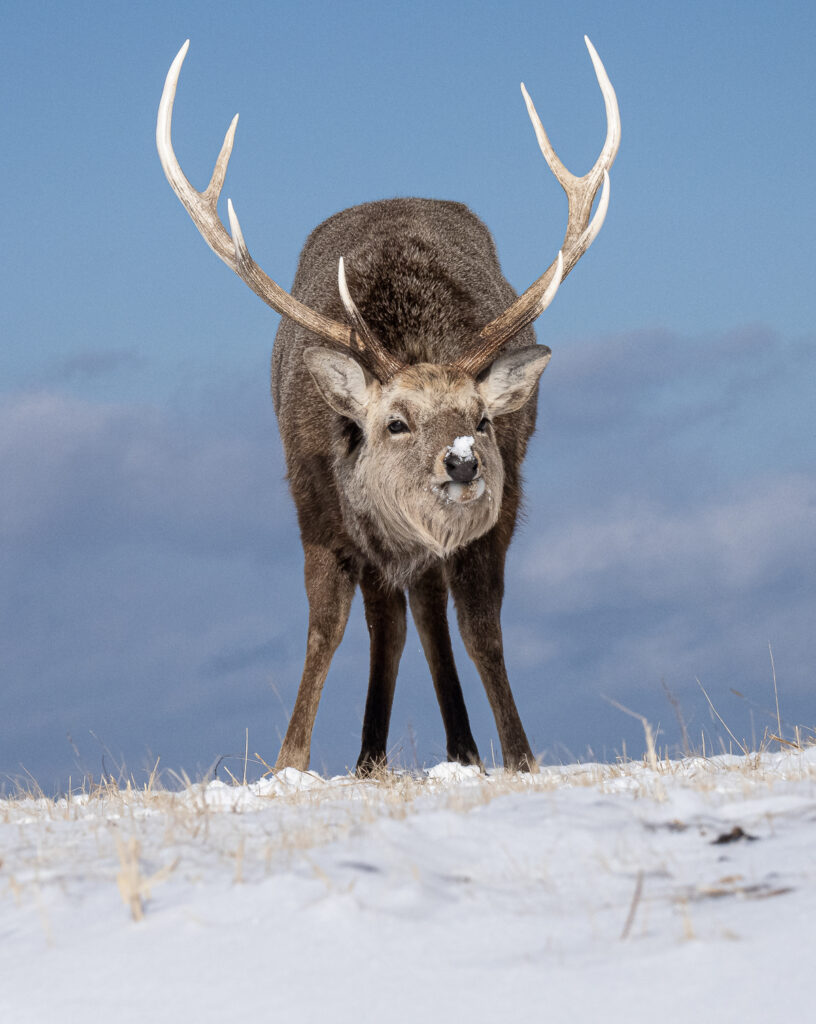
Portrait of a Sika Deer (image by Jacqui Burke). Why Wild Images loves this – The Sika Deer bucks of Japan usually have a full set of antlers during our tour. This image is wonderful as it was taken during a day of soft sunlight and the deer had obviously been foraging as there is a lump of snow on top of its nose where it had been grubbing around searching for food.
What were your first impressions of Japan for photography?
Japan was great for photography as the sightings are “guaranteed”. The cranes, snow monkeys, whooper swans, Stellar sea eagles, white-tailed eagles, and Blakiston’s fish owl are all fed, guaranteeing that they will be present at given times to be photographed. This allowed multiple attempts at flight shots, and allowed time to try some creative techniques after the standard portraits had been obtained.
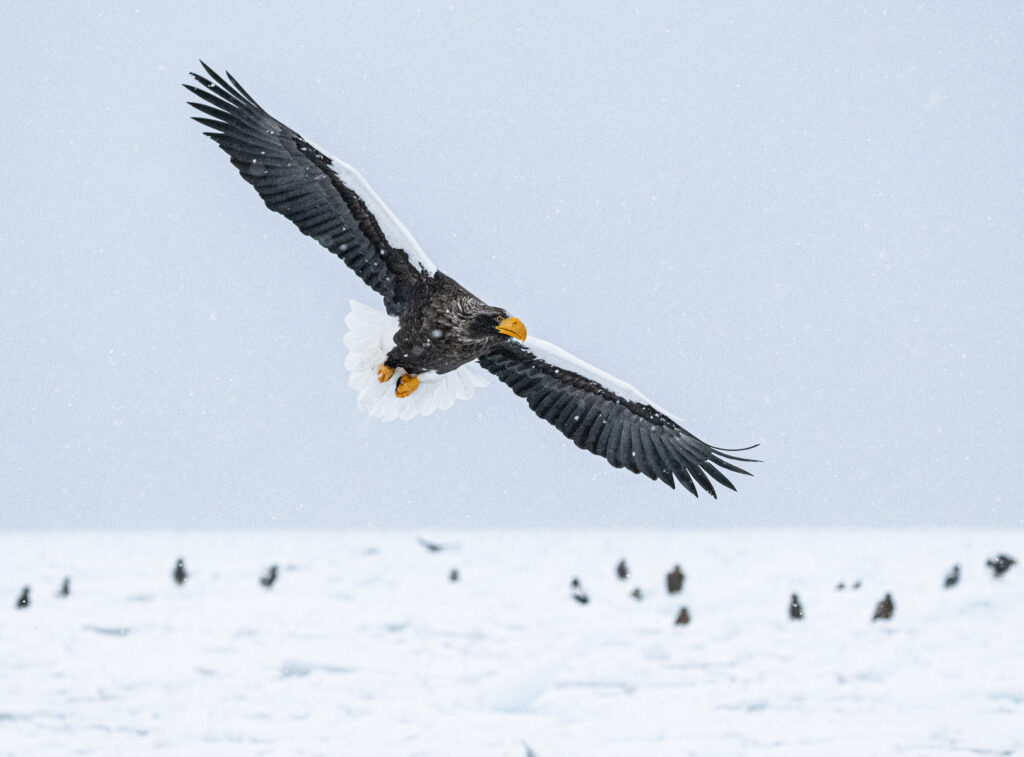
Steller’s Sea Eagle in flight over the sea ice at Rausu (image by Jacqui Burke). Why Wild Images loves this – the gigantic Steller’s Sea Eagle is one of the world’s most thumping birds of its type. They almost don’t look real with their huge orange bills and talons offsetting their black and white plumage. This photo is particularly spectacular as it shows one flying straight towards us with several perched birds sitting on the ice in the background, giving the bird in flight some size perspective.
What surprised you about your trip there?
The above. I guess I had not considered that most of the wildlife that we would see would be fed at particular sites, and rather anticipated a more safari-like experience.
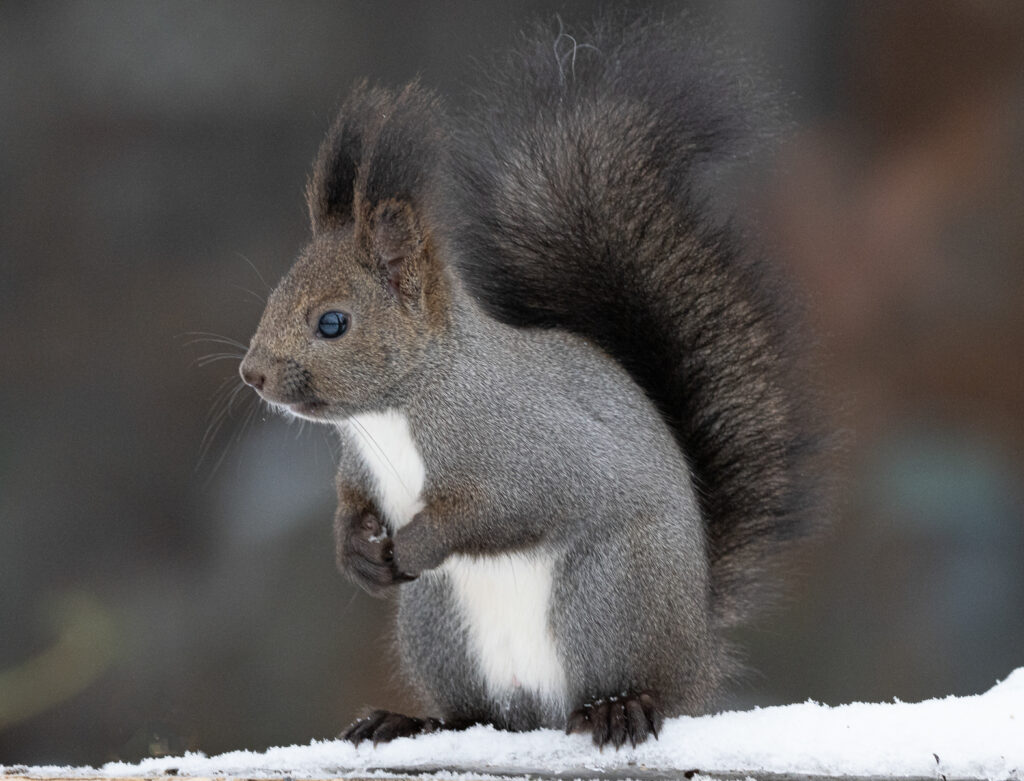
Portrait of a Eurasian Red Squirrel in the snow (image by Jacqui Burke). Why Wild Images loves this – Look at those ears! Look at that adorable little face! This gorgeous little squirrel is in a lovely position in this image with its white fur offsetting the snow he is standing on and his greyish-red fur almost blending into the lovely vegetation in the background.
What were your frustrations on your trip?
I was disappointed that the weather was too warm at the snow monkey site. I had anticipated obtaining photos of the monkeys with ice clinging to the fur around the face and seeing them in the fresh snow. Unfortunately the area around the hot tub used by the monkeys was mostly clear of snow and was actually muddy. Fewer monkeys were in the water than would have been the case if it had been colder, and the long anticipated shot of ice in the hair was not obtained. However, I still obtained many nice photos of the snow monkeys in spite of the weather conditions.
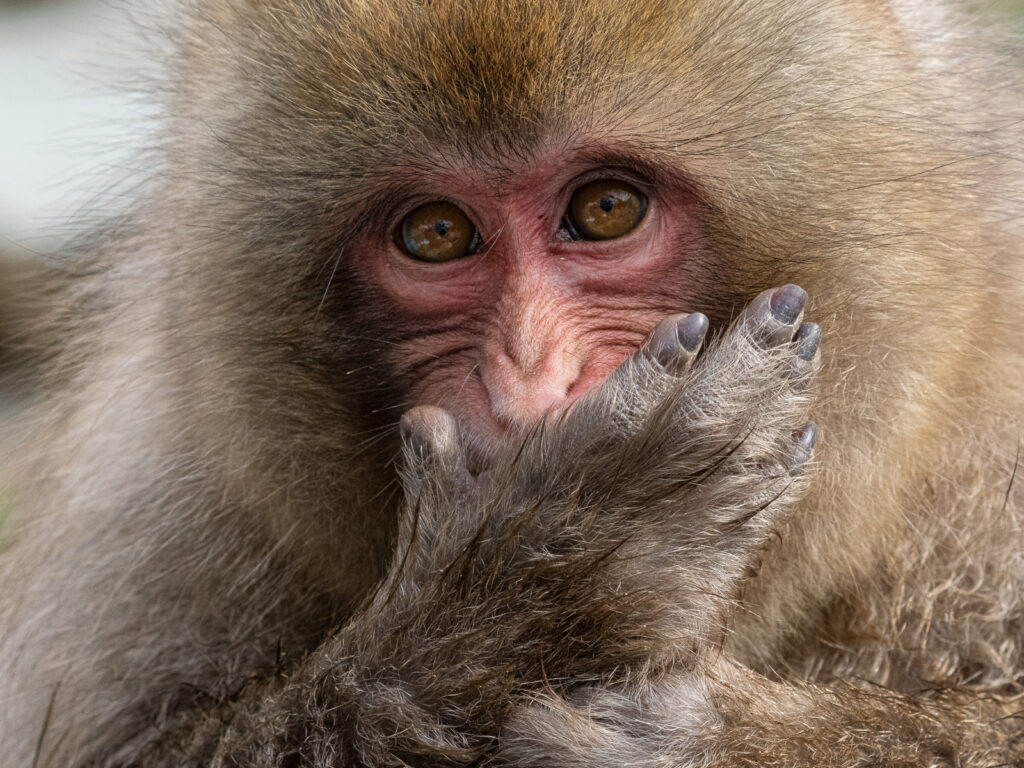
Crinkle-faced Japanese Macaque (image by Jacqui Burke). Why Wild Images loves this – When you look at photographs of Japanese Macaques it is great to see how ‘human’ they really are and although this one may have been trying to remove something from its hands, it looks like it was having a shy giggle. This photo really does show its funny little personality.
Of all the wildlife you have photographed, do you have a favourite destination you prefer to photograph?
No, I am intensely interested in all wildlife. Each species is unique and valuable in its own right. I try to return from each trip with a varied portrait of all the species I saw on the trip, rather than trying to get “wallhangers” of the charismatic megafauna only. I rarely return to a destination as I still have many places of interest to go for the first time.
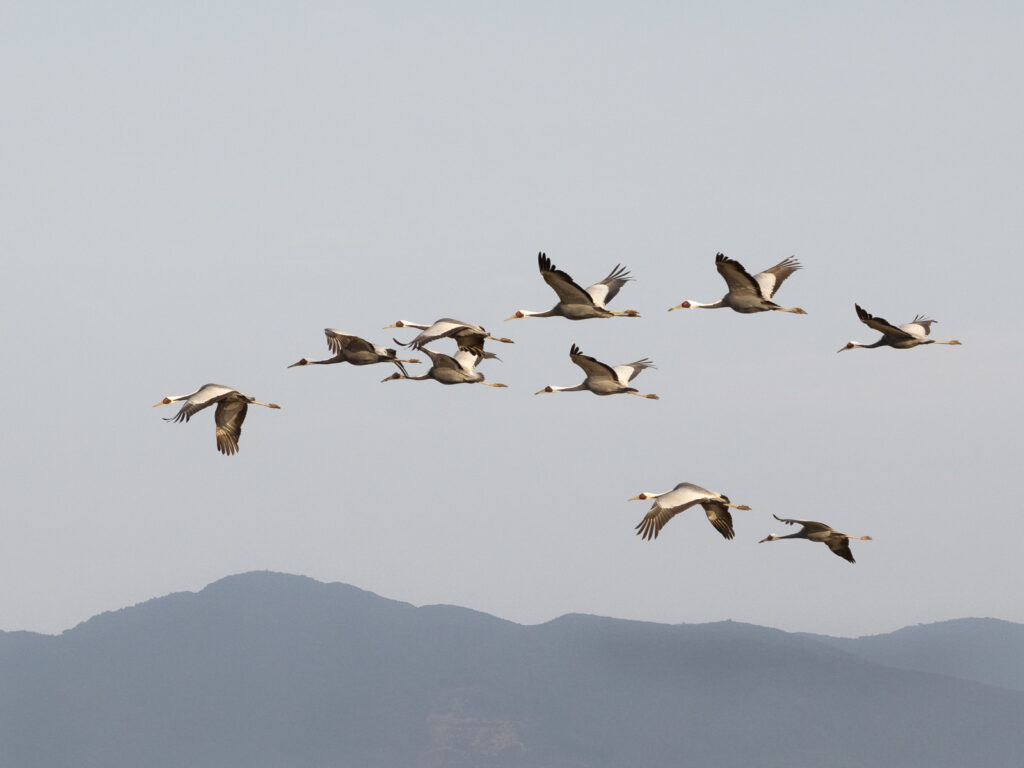
A flock of White-naped Cranes in flight over Arasaki (image by Jacqui Burke). Why Wild Images loves this – The subtle light and opportunity to photograph different species of cranes in Japan, outside the famous Red-crowned cranes of Hokkaido, is a feature of our Arasaki extension to our Japan tour. Here a flock of White-naped cranes fly against a backdrop of Arasaki’s dark hills, the arch of the flock mirroring the shape of the hills below them.
Aside from the photography, what other aspects of the tour did you enjoy?
I really enjoyed the snow! Immensely! We have not had any snow where I live for the past two years, which until recently was quite unusual. It was great to be in Hokkaido for the majority of the trip where the ground was covered in snow. It snowed just enough each day to keep the snow on the ground looking clean and fresh without making driving or other conditions difficult.
I also immensely enjoyed the Japanese baths, or onsens. After a brief moment of reticence of being nude in a public bath on the first day, all sense of modesty quickly departed and I came to love the relaxation of the hot tub with fellow trip members after a long day of photography; and it was great to finally be rid of the snow boots and parka for the day!
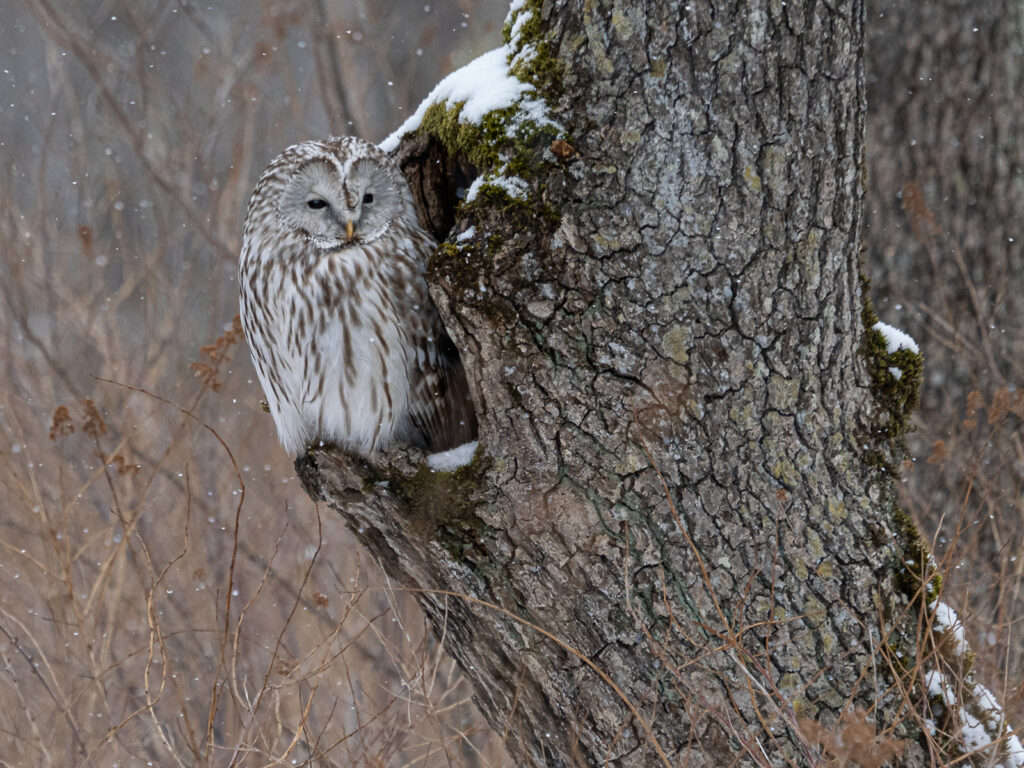
Portrait of an Ural Owl in the Snow (image by Jacqui Burke). Why Wild Images loves this – Over the years we have run our Japan tours, we’ve had some guests appear disappointed when the snow comes yet snow can create a truly magical effect in the right circumstances. This images shows that beautifully with an Ural Owl (truly a creature of the winter), peering from its roosting hole with eyes half closed, watching its wintry world with the safety from the weather nearby.
What have you learned from your tour of Japan?
On every trip, I continue to learn more about my camera and make strides in improving my photography, and the trip to Japan was not an exception. I also learned a great deal about Japanese culture and cuisine as I had little familiarity with it previously.
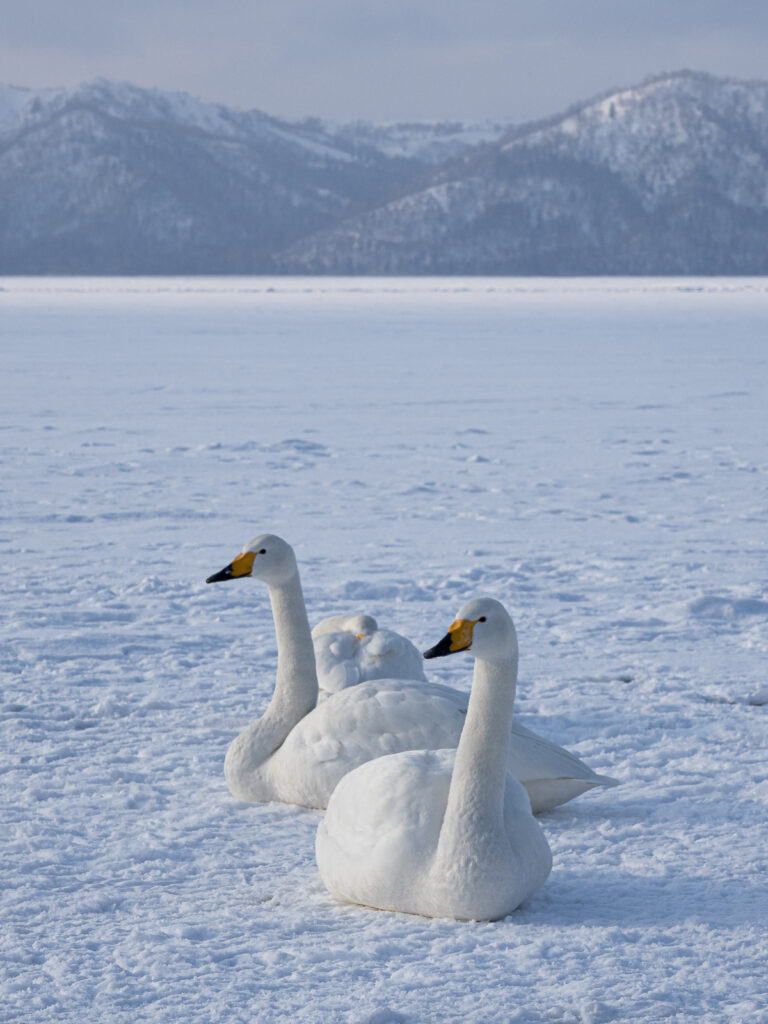
Trio of Whooper Swans resting on frozen Lake Kussharo in Japan (image by Jacqui Burke). Why Wild Images loves this – This image combines two watchful swans who seem to frame their sleeping friend behind them. Combine this with the soft lift, the frozen lake and the snow-covered hills of Hokkaido in the background and the overall feel of this photo is truly elegant.
Do you have any advice for photographers visiting Japan?
Travel light. Two camera bodies and two lenses ranging from a full frame equivalent of 24 mm to around 600 mm is enough. There were no opportunities for wide-angle greater than 24 mm and no opportunities for macro. I used a 12-100 (24-200 full frame equivalent) and a 100-400 (200-800 full frame equivalent) on the trip. Two bodies are essential as you do not want to have to change lenses outside if it is snowing.
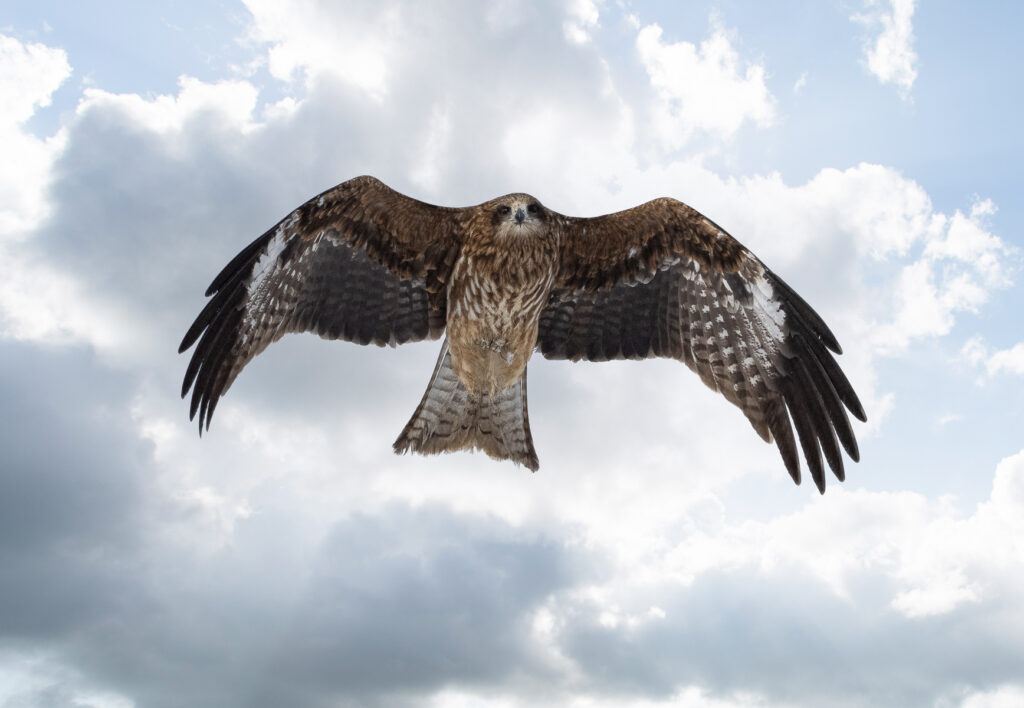
A Black-eared Kite soaring the skies (image by Jacqui Burke). Why Wild Images loves this – capturing birds in flight as they fly overhead is a tricky shot to expose correctly. Quite often you end up with a silhouetted shot of a black bird against a white sky. What is lovely about this image is that it is correctly exposed for this situation and the reflection of the snow beneath this bird allowed for just enough light to show its beautiful underwing and body plumage.
Are there any images that are particularly special to you?
I love the high-key image of the two red crowned cranes in flight. My photographic tendency is naturally towards a more documentary style, and I love when I break free of that and create something more artistic.
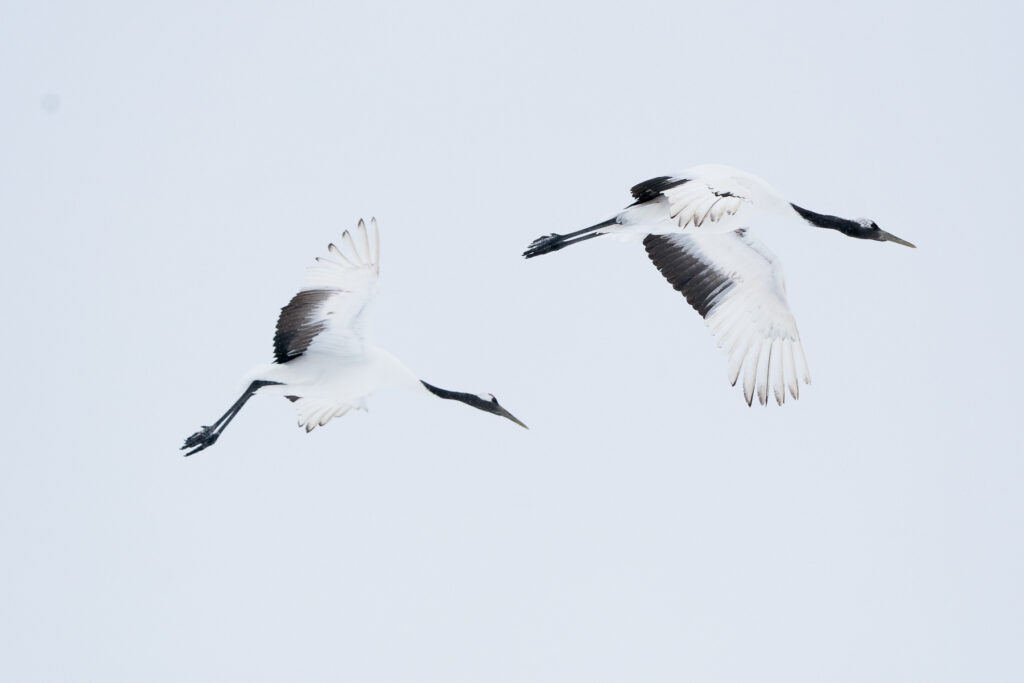
A pair of Red-crowned Cranes in Flight in Hokkaido (image by Jacqui Burke). Why Wild Images loves this – Hokkaido is probably one of the best places in the world to learn about whites in photography and high-key images, shooting both in-camera and creating these in post-processing. These beautiful cranes in flight are not only nicely positioned but the photograph has just been exposed enough to offset the whites in the cranes against the snowy background, giving it the effect of a painting almost.
Why did you enjoy these images so much?
I love looking at the images as it brings me back to the moment of being at the site taking the photograph. Although I love photography very much, the animals themselves still are the most important thing for me, and thus the photographs for me have been souvenirs rather than works of art. I am actively endeavoring to create art and a souvenir at the same time now, however, as my photography progresses.
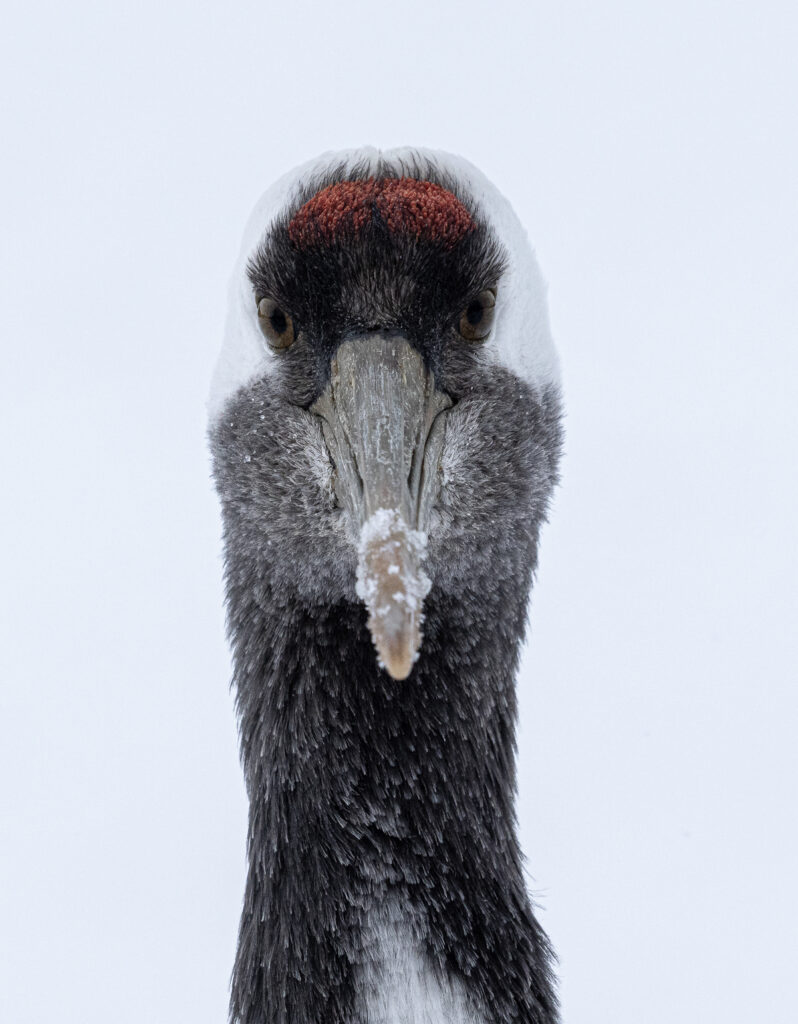
Portrait of a Red-crowned Crane (image by Jacqui Burke). Why Wild Images loves this – our tours, thankfully, allow our guests to have a number of opportunities for photographing Red-crowned Cranes but even with multiple attempts it isn’t easy to get a photo of a Red-crowned Crane looking straight at you. This is a great shot because it shows the characteristic plumage of this beautiful bird with a “Who are you looking at?” type of expression.
Would you return to Japan for photography?
I would love to return to Japan for photography after I complete my bucket list of other wildlife-rich sites. I read Mark Brazil’s wonderful book on the natural history of Japan before I went on the trip, and was truly amazed about the large variety of wildlife there as most islands are limited in their biodiversity. Not so Japan! Although I dearly loved going there in winter, perhaps I would go at a different time of year for a completely different experience.
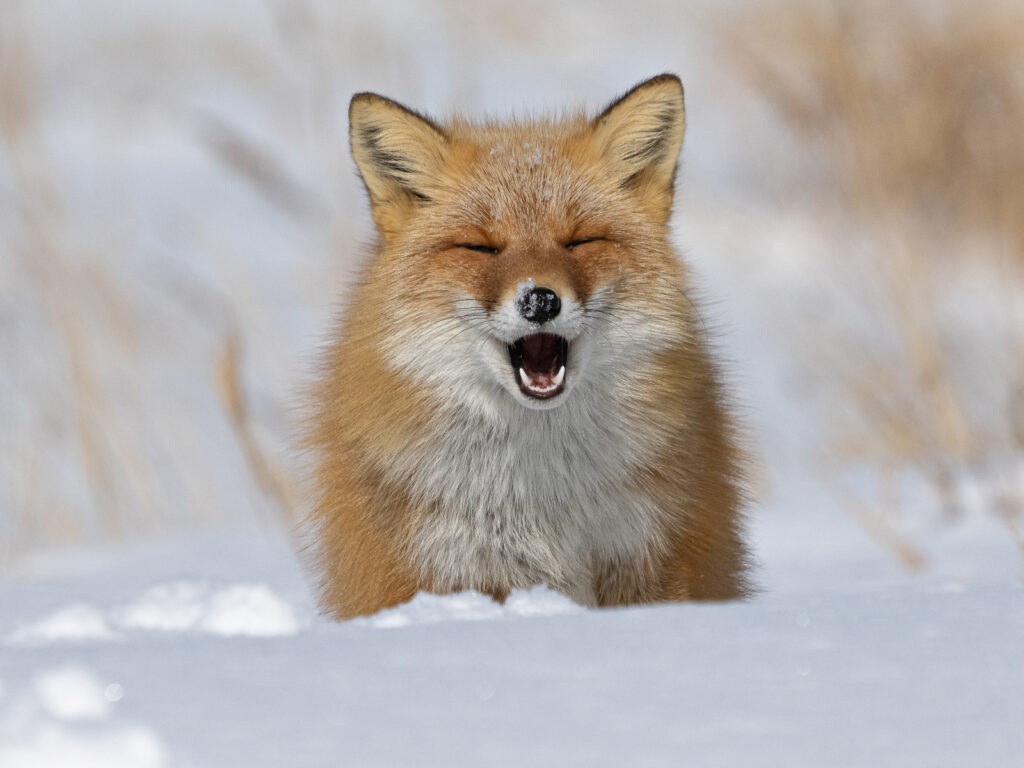
The Laughing Fox (image by Jacqui Burke). Why Wild Images loves this – who doesn’t love photographing foxes? Even if this one was in the middle of a yawn, he looks like he is laughing. The incredible soft light and the winter vegetation colours frame this little fox beautifully.
Previous Article
In Your Eyes – Interview with Ksenija Soster Olmer – Benin 2022
